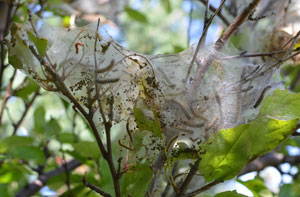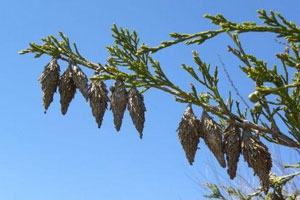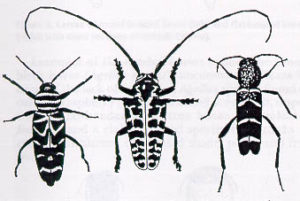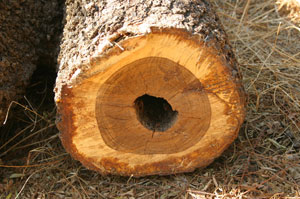 The webworm is a common pest of trees in Texas. It attacks more than 88 different kinds of plants,but does not attack conifers (pines and other needle-bearing trees). Webworms are known for the large webs they produce. Heavy infestations are rarely fatal, but if they occur repeatedly over several years they can stress trees and make them more susceptible to drought, disease or other insect pests which can be fatal. The feeding preferences of webworms vary from one place to another. In west Texas, mulberry, poplar and willow are preferred; oak, hickory and pecan are most often attacked in east Texas. While Pecans are favored in the other parts of Texas.
The webworm is a common pest of trees in Texas. It attacks more than 88 different kinds of plants,but does not attack conifers (pines and other needle-bearing trees). Webworms are known for the large webs they produce. Heavy infestations are rarely fatal, but if they occur repeatedly over several years they can stress trees and make them more susceptible to drought, disease or other insect pests which can be fatal. The feeding preferences of webworms vary from one place to another. In west Texas, mulberry, poplar and willow are preferred; oak, hickory and pecan are most often attacked in east Texas. While Pecans are favored in the other parts of Texas.
There are two to four generations of webworms each year in Texas. Four generations occur in southern portions of the state, while two to three generations occur in the northern areas. The first generation occurs as early as April in south Texas and as late as June around Lubbock and Amarillo. The last generation of the year, which occurs in the fall, is usually the most damaging and gives the insect its name.
The mass of webbing spun by fall webworms is known as a nest. Each nest can contain hundreds of webworms. The webworm caterpillars within a nest all hatched from the same mass of eggs laid by a female fall webworm moth. The caterpillars feed together for several weeks, expanding the web as needed. Nests can expand to three feet across or more. Fall webworms feed within their nest until they reach full size, at which time they crawl out of the nest, and usually away from the tree, to form a cocoon. Caterpillars from one nest will not crawl to other trees to form new nests.
If you suspect that you have a trees suffering from a fall webworm infestation or another infection, call L & A Tree Service at 903-357-9292 or contact us now for assistance.
 Bagworm caterpillars make distinctive 1.5 to 2 inch long spindle-shaped bags that can be seen hanging from twigs of a variety of trees and shrubs. Sometimes the bags are mistaken for pine cones or other plant structures. Bagworms are native to the United States and common in Texas.
Bagworm caterpillars make distinctive 1.5 to 2 inch long spindle-shaped bags that can be seen hanging from twigs of a variety of trees and shrubs. Sometimes the bags are mistaken for pine cones or other plant structures. Bagworms are native to the United States and common in Texas.
Bagworms prefer juniper, arborvitae, spruce, pine, and cedar but also attack deciduous trees. Female moths cannot fly but the larvae can disperse. Very small caterpillars can spin strands of silk and be carried by wind, an activity called “ballooning”. Larger larvae may crawl to adjacent plants.
Bagworm caterpillars feed for about six weeks, enlarging the bag as they grow and withdrawing into it when disturbed. Older larvae strip evergreens of their needles and devour whole leaves of susceptible deciduous species leaving only the larger veins. When abundant, the caterpillars can defoliate plants. Heavy infestations over several consecutive years, especially when coupled with other stresses, can lead to plant death.
If you suspect that you have a trees suffering from infestation or another infection, call L & A Tree Service at 903-357-9292 or contact us now for assistance.
 Many insects feed and make their homes in the bark, trunks and branches of shade trees and shrubs in Texas. Some of the most damaging are those that bore into the bark and wood of your trees. Bark beetles and insect borers belong to several different insect groups including a variety of beetles, moths and horntail wasps.
Many insects feed and make their homes in the bark, trunks and branches of shade trees and shrubs in Texas. Some of the most damaging are those that bore into the bark and wood of your trees. Bark beetles and insect borers belong to several different insect groups including a variety of beetles, moths and horntail wasps.
Most insect borers are attracted to weakened, damaged, dying or dead plants. These are referred to as “secondary invaders” because they attack only after a plant has been weakened by another stress. While other wood-boring insects that attack healthy trees and shrubs are called “primary invaders.” Primary invaders may eventually kill trees.
Borer infestations often go unnoticed until plants or parts of plants begin to die or show external signs of damage. Wood-boring insects often produce sawdust-like frass. Their holes are normally round, oval or semicircular and are found in a random pattern on the plant.
Many borers damage plants by tunneling through the inner bark layer into the sapwood that transports nutrients and water to the leaves. These insects are called phloem feeders. When the cambium layer is completely girdled the plant eventually dies above or beyond the damage site. Partial girdling reduces plant growth and vigor above the site of attack. On occasion, tunneling makes the tree weak, causing limbs and branches to fall.
If you suspect that you have a tree suffering from an attack of boring beetles or other wood boring insects, call L & A Tree Service at 903-357-9292 or contact us now for assistance.
 In trees, heart rot is a fungal disease that causes the decay of wood at the center of the trunk and branches. Fungi enter the tree through wounds in the bark and decay the heartwood. The diseased heartwood softens resulting in trees being structurally weaker and prone to breakage. Tree heart rot is prevalent throughout the world affecting all hardwood trees and can be very difficult to prevent. A good indication of heart rot is the presence of mushrooms or fungus conks on the tree.
In trees, heart rot is a fungal disease that causes the decay of wood at the center of the trunk and branches. Fungi enter the tree through wounds in the bark and decay the heartwood. The diseased heartwood softens resulting in trees being structurally weaker and prone to breakage. Tree heart rot is prevalent throughout the world affecting all hardwood trees and can be very difficult to prevent. A good indication of heart rot is the presence of mushrooms or fungus conks on the tree.
The prevention of tree heart rot can be a very difficult task, but there are effective measures to minimize damage. These methods include facilitating healthy growth, minimizing wounds, and proper pruning of branches. A healthy tree naturally combats tree heart rot through a process called compartmentalization. The tree grows around the decayed wood tissue and prevents the fungus from spreading to a larger area of the trunk. Providing a tree with the necessary nutrients, water, and growing conditions will promote healthy growth and minimize rot. The bark is the tree's main defense against disease; reducing the amount of large wounds and bare wood, especially in older trees, helps prevent rot.
Pruning focuses on removing dead or diseased branches with minimal damage done to the tree. Branches connect to the trunk and grow from the branch collar. While the branch itself may be dead, the branch collar is still healthy and resistant to disease. It is from the branch collar that a new limb will generate and grow, so it is important not to damage it while pruning. Improper pruning will inhibit the growth process and provide fungi with ideal growth environments. A professional tree service can properly prune your trees for you.
If you suspect that you have a tree suffering from tree heart rot or another infection, call L & A Tree Service at 903-357-9292 or contact us now for assistance.
